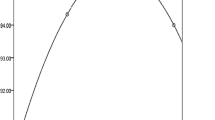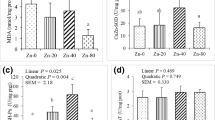Abstract
This study was conducted to investigate the effects of vitamin E, vitamin C, probiotics, dietary protein level, and their combination on semen traits and seminal plasma macro- and microminerals in 65-week-old male broiler breeders after zinc-induced molting. One hundred eighty birds were induced to molt by mixing zinc oxide (3,000 mg/kg) in the diet. The birds were divided into six groups (five replicates) by completely randomized design. One group was kept as control (16% CP), while the other five were supplemented with vitamin E (100 IU/kg feed), vitamin C (500 IU/kg feed) probiotics (50 mg/L), protein level (14% CP), and their combination. Semen samples were weekly collected for determination of semen volume, sperm concentration, motility, and dead sperm percentage. Analyses of Na, K, Ca and Mg, Zn, Fe, Mn, and Cu in seminal plasma were also performed. Overall, mean semen volume was significantly high in vitamin E and C supplemented groups compared to control. Overall mean sperm motility was significantly higher in vitamin E supplemented group, whereas dead sperm percentage was significantly lower in the vitamin C group compared to control. Mineral analyses revealed that overall mean seminal plasma Mg increased significantly in vitamin E and C supplemented groups compared to control. Similarly, significantly high overall mean seminal plasma Cu concentration was observed in vitamins E and C and combination groups. It can be concluded that vitamins have a vital role in improving semen quality and bioavailability of Mg and Cu in seminal plasma of the post-molt cockerels.








Similar content being viewed by others
References
Sandhu MA, Rahman ZU, Rahman SU (2007) Effects of induced molting on some immunological parameters in laying hens (Gallus domesticus). Arch Geflügelk 71:110–116
Khan RU, Nikousefat Z, Javdani M, Tufarelli V, Laudadio V (2011) Zinc-induced moulting: production and physiology. World Poult Sci J 67:469–478
Woodard AE, Ogasawara FX, Snyder RL, Stinnett V (1975) Effect of forced molting on quantity and quality of semen in turkey breeder males as influenced by diet. Poult Sci 54:2094–2101
Woodard AE, Synder RL, Fuqua L (1979) The effect of photoperiod and feed restriction on semen production in the turkey. Poult Sci 58:217–221
Jacquet JM, Seigneurin M, De Reviers E (1993) Induced moulting in cockerels: effects on sperm production, plasma concentrations of luteinising hormone, testosterone and thyroxine, and on pituitary sensitivity to luteinising hormone-releasing hormone. Br Poult Sci 34:765–777
Yousaf MS, Rahman ZU, Sandhu MA, Bukhari SA, Yousaf A (2009) Comparison of the fast-induced and high dietary zinc-induced molting: trace elements dynamic in serum and eggs at different production stages in hens (Gallus domesticus). J Anim Physiol Anim Nutr 93:35–43
Rutz F, Anciuti MA, Rech JL, Rossi P (2004) The importance of organic minerals on performance of poultry. XVI Annual Australian Poultry Science Symposium, Sydney, Australia, pp 71–74
Hong CY, Chiang BN, Turner P (1984) Calcium ion is the key regulator of human sperm function. Lancet 2:1449–1451
Wong WY, Flik G, Groenen PMW, Swinkels DW, Thomas CMG, Copius-Peereboom JHJ, Merkus HMWM, Steegers-Theunissen RPM (2001) The impact of calcium, magnesium, zinc and copper in blood and seminal plasma on semen parameters in men. Rep Toxicol 15:131–136
Aghaei A, Tabatabaei S, Nazari M (2010) The correlation between mineral concentration of seminal plasma and spermatozoa motility in rooster. J Anim Vet Adv 9:1476–1478
Surai PF, Brillard JP, Speake BK, Blesbois E, Seigneurin F, Sparks NH (2000) Phospholipids fatty acid composition, vitamin E content and susceptibility to lipid peroxidation of duck spermatozoa. Theriogenology 53:1025–1039
McDowell LR (1989) Vitamins in animal nutrition. Academic, New York
Gous RM, Morris TR (2005) Nutritional interventions in alleviating the effects of high temperatures in broiler production. World Poult Sci J 61:463–475
Panda AK, Reddy MR, Rama SV, Praharaj NK (2003) Production performance, serum/yolk cholesterol and immune competence of White Leghorn layers as influenced by dietary supplementation with probiotic. Tropical Anim Health Prod 35:85–94
Fuller R (1989) Probiotics in man and animals. J Appl Bacteriol 66:365–378
Zhang X, Berry WD, McDaniel GR, Roland DA, Liu P, Calvert C, Wilhite R (1999) Body weight and semen production of broiler breeder males as influenced by crude protein levels and feeding regimens during rearing. Poult Sci 78:190–196
Burrows WH, Quinn JP (1937) The collection of spermatozoa from the domestic fowl and turkey. Poult Sci 26:19–24
Blom E (1950) A 1-min live–dead sperm stain by means of eosin–nigrosin. J Fert Steril 1:176–177
Richard LA (1968) Diagnosis and improvement of saline and alkaline soil, 1st edn. Agri. Handbook no. 60. IBH, New Delhi
Steel RGD, Torrie JH, Dieky DA (1997) Principles and procedures of statistics, 3rd edn. McGraw Hill, New York
Duncan DB (1955) Multiple range and multiple F-test. Biometries 11:1–42
Lin YF, Chang SJ, Yang JR, Lee YP, Hsu L (2005) Effects of supplemental vitamin E during the mature period on the reproductive performance of Taiwan native chicken cockerels. Br Poult Sci 46:366–373
Biswas A, Mohana J, Sastrya KVH (2009) Effect of higher dietary vitamin E concentrations on physical and biochemical characteristics of semen in Kadaknath cockerels. Br Poult Sci 50:733–738
Ceroloni S, Zaniboni L, Maldjian A, Gliozzi T (2006) Effect of docosahexaenoic acid and α-tocopherol enrichment in chicken sperm on semen quality, sperm lipid composition and susceptibility to peroxidation. Theriogenology 66:877–886
Eid Y, Ebeid T, Younis H (2006) Vitamin E supplementation reduces dexamethasone-induced oxidative stress in chicken semen. Br Poult Sci 47:350–356
Surai PF, Kutz E, Wishart GJ, Noble RC, Speake BK (1997) The relationship between the dietary provision of alpha-tocopherol and the concentration of this vitamin in the semen of chicken: effects on lipid composition and susceptibility to peroxidation. J Rep Fert 110:47–51
Surai PF, Kostjuk I, Wishart G, Pherson AMAC, Speake BK, Noble RC, Ionov I, Kutz E (1998) Effect of vitamin E and selenium supplementation of cockerel diets on glutathione peroxidase activity and lipid peroxidation susceptibility in sperm, testes, and liver. Biol Trace Element Res 64:119–132
Pardue SL, Thaxton JP (1986) Ascorbic acid in poultry: a review. World Poult Sci J 42:107–123
Dobrescu O (1987) Vitamin C addition to breeder diets increase turkey semen production. Feedstuffs 59:18
Elansary E, Elsharawy G, Asar M, Waleed F (1999) Effect of ascorbic acid on semen characteristics of Alexandria cockerels under hot ambient temperatures. Poult Sci 78:35, Abstract
McDaniel CD, Hannah JL, Parker HM, Smith TW, Schultz CD, Zumwalt CD (1998) Use of a sperm quality analyzer for evaluating broiler breeder males: effects of altering sperm quality and quantity on the sperm motility index. Poult Sci 77:888–893
Yousef MI, Abdallah GA, Kamel KI (2003) Effect of ascorbic acid and vitamin E supplementation on semen quality and biochemical parameters of male rabbits. Anim Rep Sci 76:99–111
Nowaczewski S, Kontecka H (2005) Effect of dietary vitamin C supplement on reproductive performance of aviary pheasants. Czech J Anim Sci 50:208–212
Garcia LA, Dejong SC, Martin SM, Smith RS, Buettner GR, Kerber RE (1998) Magnesium reduces free radicals in an in vivo coronary occlusion-reperfusion model. J Am Coll Cardiol 32:536–539
Sahin K, Smith MO, Onderci M, Sahin N, Gursu MF, Kucuk O (2005) Supplementation of zinc from organic or inorganic source improves performance and antioxidant status of heat-distressed quail. Poult Sci 84:882–887
Chan S, Gerson B, Subramaniam S (1998) The role of copper, molybdenum, selenium, and zinc in nutrition and health. Clin Lab Med 18:673–685
De Lamirande E, Gagnon C (1995) Human sperm hyperactivation in whole semen and its association with low superoxide scavenging capacity in seminal plasma. Fert Steril 59:1291–1295
Khan RU, Zia-ur-Rahman, Hasan IJ, Muhammad F (2011) Effect of vitamins, probiotics and protein on seminal plasma biochemical parameters of male broiler breeders. Br Poult Sci (in press)
Chen LH (1981) An increase in vitamin E requirement induced by high supplementation of vitamin C in rats. Am J Clin Nutr 34:1036–1041
Aburto A, Britton WM (1998) Effects of different levels of vitamins A and E on the utilization of cholecalciferol by broiler chickens. Poult Sci 77:570–577
Acknowledgment
The study is a part of research conducted under 5000 indigenous PhD fellowship (Batch IV) scheme funded to the first author by the Higher Education Commission (HEC) of Pakistan.
Author information
Authors and Affiliations
Corresponding author
Rights and permissions
About this article
Cite this article
Khan, R.U., Zia-ur-Rahman, Javed, I. et al. Effects of Vitamins, Probiotics, and Protein Level on Semen Traits and Some Seminal Plasma Macro- and Microminerals of Male Broiler Breeders After Zinc-Induced Molting. Biol Trace Elem Res 148, 44–52 (2012). https://doi.org/10.1007/s12011-012-9341-9
Received:
Accepted:
Published:
Issue Date:
DOI: https://doi.org/10.1007/s12011-012-9341-9




